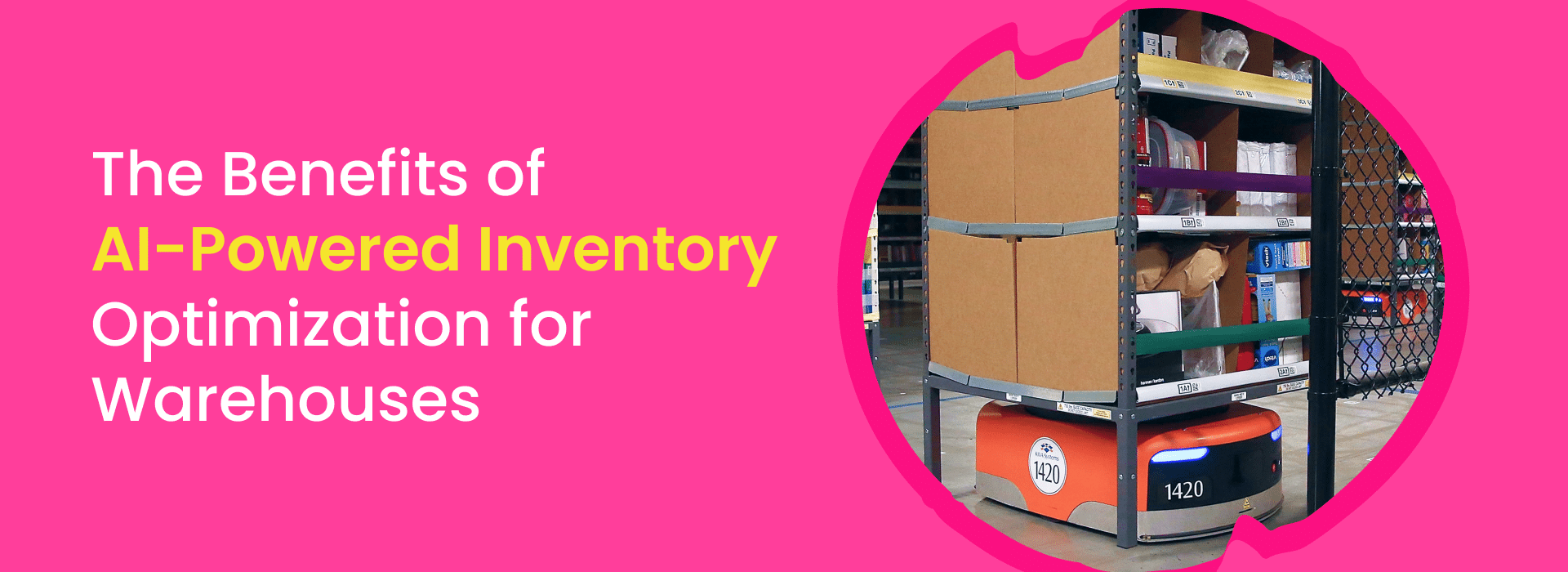
In the fast-paced world of logistics and supply chain management, efficient warehouse operations are crucial. Traditional inventory management methods often struggle to keep up with the demands of modern businesses, leading to inefficiencies, errors, and increased costs. Enter Artificial Intelligence (AI) – a game-changer that brings precision, efficiency, and scalability to inventory management. This guide explores the benefits of AI-powered inventory optimization, highlighting how it can transform warehouse operations.
The Challenges of Traditional Inventory Management
Manual Processes Prone to Errors and Inefficiencies
Traditional inventory management relies heavily on manual processes for tracking, ordering, and replenishing stock. This approach is not only time-consuming but also prone to human errors. A misplaced decimal or a missed entry can lead to significant discrepancies in inventory data, resulting in stockouts or overstocking. Our AI development services can help automate these processes, reducing errors and inefficiencies. According to the National Retail Federation, inventory shrinkage, which includes errors, cost U.S. retailers over $60 billion in 2019.
Difficulty in Predicting Demand Variations
Accurately forecasting demand is a constant challenge for warehouse managers. Traditional methods often fail to account for sudden market shifts, seasonal trends, or changing customer preferences. This can lead to either excess inventory, tying up capital and increasing holding costs, or stockouts, causing missed sales opportunities. The Harvard Business Review notes that companies with ineffective demand forecasting can experience up to a 20% reduction in sales.
Inaccurate Inventory Data Leading to Stockouts or Excess Stock
Inaccurate or outdated inventory data can have a ripple effect throughout the supply chain. Stockouts result in lost sales and disappointed customers, while overstocking leads to high carrying costs and potential obsolescence of products. The Warehousing Education and Research Council (WERC) reports that the average carrying cost of inventory in the U.S. is between 20-30% of the total inventory value annually.
How AI Optimizes Your Warehouse Inventory
Demand Forecasting with AI
Predicting Future Sales Trends and Customer Needs
AI algorithms analyze vast amounts of data from various sources, including historical sales, market trends, and customer behavior. This enables more accurate demand forecasting, allowing businesses to anticipate future sales trends and customer needs with greater precision. According to McKinsey, AI-powered demand forecasting can improve forecast accuracy by up to 20-30%.
Optimizing Inventory Levels Based on Anticipated Demand
With better demand forecasts, warehouses can optimize their inventory levels to match anticipated demand. This reduces the risk of stockouts and overstocking, ensuring that the right products are available at the right time. Research by Bain & Company shows that companies using AI for inventory optimization can reduce stockouts by up to 65%.
Reducing the Risk of Stockouts and Overstocking
AI continuously monitors inventory levels and adjusts reorder points based on real-time data and predictive analytics. This proactive approach minimizes the risk of stockouts and overstocking, enhancing overall inventory efficiency. A study by Accenture found that AI-driven inventory management could reduce inventory carrying costs by up to 50%.
Automated Inventory Replenishment
Setting Reorder Points Based on Real-Time Data and AI Analysis
AI systems use real-time data to set optimal reorder points, ensuring timely replenishment of stock. This eliminates the guesswork involved in manual ordering processes and reduces the likelihood of human error. The International Journal of Production Economics reports that AI-driven replenishment systems can improve order accuracy by 99%.
Eliminating Manual Ordering and Reducing Human Error
By automating the replenishment process, AI reduces the reliance on manual interventions, thereby minimizing human error. This leads to more accurate and efficient inventory management. According to a survey by Robotics Business Review, 72% of companies implementing AI in their supply chains reported significant reductions in manual errors.
Ensuring Optimal Stock Levels at All Times
AI ensures that stock levels are consistently optimized, preventing both shortages and excess inventory. This balanced approach improves cash flow and enhances customer satisfaction by ensuring product availability. A report by Deloitte highlights that AI can lead to a 20-25% reduction in inventory-related costs.
Improved Space Utilization
Analyzing Historical Data and Predicting Future Demand for Different Products
AI analyzes historical sales data and predicts future demand for various products, enabling better space utilization within the warehouse. This ensures that high-demand items are easily accessible, reducing picking times and improving efficiency. The Material Handling Institute reports that AI-optimized storage layouts can increase picking efficiency by 20-40%.
Optimizing Storage Layouts for Faster Picking and Higher Efficiency
With AI, warehouses can design optimal storage layouts that streamline picking and packing processes. This reduces travel time within the warehouse, speeding up order fulfillment and boosting productivity. According to the Journal of Business Logistics, warehouses using AI for layout optimization saw a 30% increase in order fulfillment speed.
Minimizing Wasted Warehouse Space
AI helps identify and eliminate wasted space, ensuring that every inch of the warehouse is utilized efficiently. This maximizes storage capacity and reduces the need for additional warehousing space. Research by the Warehousing Education and Research Council (WERC) shows that efficient space utilization can lead to a 15-25% reduction in storage costs.
Reduced Carrying Costs
Minimizing Storage and Handling Costs for Slow-Moving Items
AI identifies slow-moving items and adjusts inventory levels accordingly, reducing storage and handling costs. This targeted approach ensures that warehouse space is used efficiently, lowering overall carrying costs. A study by McKinsey found that AI-driven inventory management could reduce carrying costs by up to 30%.
Optimizing Inventory Levels to Avoid Overstocking
By maintaining optimal inventory levels, AI helps avoid the costs associated with overstocking, such as increased storage, insurance, and obsolescence. This leads to significant cost savings and improved profitability. The Harvard Business Review notes that effective inventory optimization can increase profitability by up to 5-10%.
Improving Overall Warehouse Profitability
With reduced carrying costs and optimized inventory levels, warehouses can significantly improve their profitability. AI-driven inventory management ensures that resources are used efficiently, enhancing the bottom line. According to a report by Gartner, companies using AI for inventory optimization saw a 25% increase in profitability.
Additional Benefits of AI in Inventory Management
Increased Order Picking Accuracy and Speed
AI improves the accuracy and speed of order picking by optimizing routes and utilizing automated systems. This leads to faster order fulfillment and higher customer satisfaction. The Material Handling Institute reports that AI-driven picking systems can improve accuracy by up to 99.9%.
Enhanced Data-Driven Decision Making for Warehouse Operations
AI provides valuable insights and data-driven recommendations for warehouse operations, enabling managers to make informed decisions. This enhances overall efficiency and effectiveness. According to Deloitte, companies using AI for decision-making reported a 50% improvement in operational efficiency.
Improved Worker Productivity and Safety
By automating repetitive and physically demanding tasks, AI improves worker productivity and safety. This leads to a safer work environment and higher employee satisfaction. OSHA states that implementing automation can reduce workplace injuries by 15-25%.
For a comprehensive solution, our AI development services can help create an efficient and user-friendly system tailored to your needs.
Getting Started with AI-Powered Inventory Optimization
Identifying Your Specific Inventory Challenges
Begin by identifying the specific challenges and pain points in your inventory management process. Understanding your needs will help you choose the right AI solutions.
Evaluating Different AI Solutions and Their Functionalities
Research and evaluate various AI solutions available for inventory optimization. Consider factors like ease of integration, scalability, and cost-effectiveness.
Integrating AI with Existing Warehouse Management Systems (WMS)
Ensure that the chosen AI solutions can seamlessly integrate with your existing WMS. This will enable smooth implementation and operation.
Training Employees on Using AI for Inventory Management
Provide comprehensive training to your employees to ensure they are comfortable and proficient in using AI-powered systems. This will maximize the benefits of AI in your warehouse.
Ayraxs: Your Partner in AI-Powered Inventory Optimization
Expertise in AI Solutions for Warehouses
Ayraxs specializes in providing AI-driven solutions tailored to optimize warehouse operations. Our expertise ensures that your warehouse runs efficiently and effectively.
Implementing Customized AI Systems for Inventory Optimization
We work closely with you to implement AI systems customized to your specific needs, ensuring seamless integration and maximum benefits.
For a comprehensive solution, our Web Design and Development Services can help create an efficient and user-friendly system tailored to your needs.
FAQs
Is AI Difficult to Implement in Warehouses?
While AI implementation requires careful planning and investment, it is manageable with the right partner. Ayraxs provides support throughout the implementation process.
Can AI Completely Replace Inventory Managers?
AI is designed to augment, not replace, human roles. Inventory managers will continue to play a crucial role, using AI to make more informed and efficient decisions.
What Data Does AI Use for Inventory Optimization?
AI uses data from various sources, including historical sales, market trends, and real-time inventory levels, to optimize inventory management.
How Much Does AI-Powered Inventory Management Cost?
The cost varies based on the complexity and scale of the implementation. However, the long-term savings and efficiency gains often justify the investment.
How Can I Measure the ROI of Implementing AI in My Warehouse?
Measure the ROI by tracking key performance indicators such as reduced carrying costs, improved order accuracy, and increased efficiency. Compare these metrics before and after AI implementation to assess its impact.





